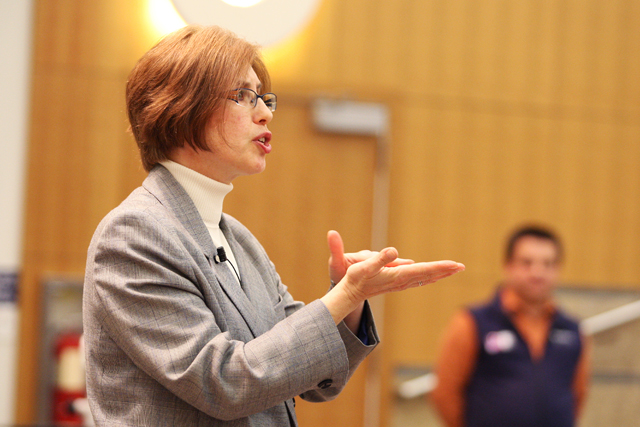Deadly diseases leave mark on history
Cholera, influenza, HIV/AIDS and anthrax were four deadly diseases discussed in a speech Friday by Jeanne Small, physical chemist and researcher at the University of Washington.
Small presented a slide show at the speech that described these epidemics and the history behind each one. She used art, history and Hollywood movies to explain the diseases in her slide show. She also discussed the scientists that worked with these epidemics and discussed which ones are considered heroes and which ones are not.
First she talked about cholera, which is a waterborne bacterium.
“(Cholera) is a disease of the slums,” she said.
Small said cholera is most rampant in cities that are densely populated. She said cholera is spread when water becomes contaminated by human fecal matter and then people drink the water. She said John Snow, physician turned epidemiologist, is considered a hero because he found the cause of the epidemic. She said this disease still exists today all over the world and can always be a threat if water becomes contaminated.
Next Small talked about influenza, also known as “the Spanish flu of 1918.” She said influenza was a global issue many years ago and because it was an airborne epidemic many people at the time could be seen wearing face masks. Influenza is very contagious and people didn’t know what caused it, she said.
The Centers for Disease Control and Prevention team resurrected this virus recently from preserved tissue samples from a 1918 flu victim, Small said. They hope to find out more about influenza and hopefully can prevent it from ever happening again, she said.
“We learned a lot about influenza,” Small said. “We know the next influenza pandemic can have several factors, we now know that there is always the threat of these viruses jumping from animals to humans and we also know that it can spread rapidly by dense populations and global travel.”
The next disease Small discussed was HIV/AIDS.
“AIDS is a very, very serious disease, but luckily it has never gone airborne,” she said.
Robert Gallo and French scientists determined AIDS was caused by HIV. Small said it was important for researchers to find the virus so they could create a blood test. She said the blood test, ELISA, was available by 1985 and has been a huge help in trying to fix this epidemic.
Lastly, Small talked about anthrax. She said anthrax is a modern biosecurity scare because it is very deadly and can be distributed easily.
“I think what we can learn from this is that we need to protect our air, water and soil. We need to be gentle to our planet earth,” she said.
She stressed the importance of using caution when making assumptions scientifically about these diseases.
“We must ‘think – know – prove’ all of our scientific assumptions and this world can end up being a much safer place.”
The speech took place at the Eccles Science Learning Center Auditorium as part of the Science Unwrapped series. More information about the speech and about Science Unwrapped can be found on the College of Science’s Web site.
–s.k.b@aggiemail.usu.edu

